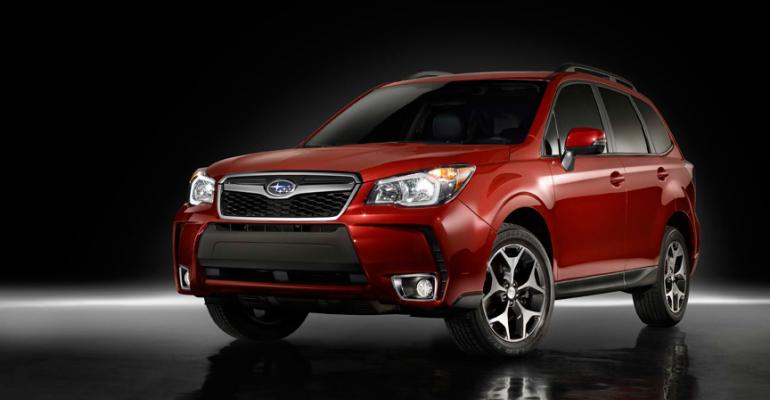Subaru says its fourth-generation Forester cross/utility vehicle, unveiled tonight in Los Angeles on the eve of the opening of the L.A. Auto Show to media, has more room for passengers and cargo and boasts better fuel economy and handling.
The new CUV goes on sale this spring and, as expected, gets a turbocharged variant of the 2.0L “FA” Boxer 4-cyl. in the Subaru BRZ/Scion FR-S sports cars.
The new 250-hp, direct-injected engine will be available only in the new Forester XT grade. The mill boasts a 10.6:1 compression ratio and Subaru’s Dual Active Valve Control System.
The 250 hp comes on at 5,600 rpm, Subaru says, while the torque peak of 258 lb.-ft. (350 Nm) is sustained over a broad speed band from 2,000 to 4,800 rpm.
Subaru’s naturally aspirated 2.5L DOHC 4-cyl. boxer carries over for the base car, with the same 170-hp peak as in the previous-generation Forester.
In the Forester 2.0XT model, the engine is mated to a high-torque, continuously variable transmission, standard with paddle shifters. Both the high-end torque and base CVT have new adaptive controls, which Subaru says continually optimize “gear” ratios based on driving inputs.
A 6-speed manual transmission is standard on the 2.5i model.
Also exclusive to the 2.0XT version is Subaru Intelligent Drive, which varies throttle response based on three driver-selectable modes: Intelligent, Sport and Sport Sharp.
For all ’14 Foresters, the rear double-wishbone suspension gets pillow-ball joint mounts on lateral links. In the sporty 2.0XT grade, front springs are 10% stiffer and rear springs 20% stiffer than those in 2.5L models.
As usual, all Foresters come with standard all-wheel drive. The 2.0XT and the Limited and Touring grades of the 2.5i models have a new X-Mode that optimizes engine, transmission and AWD operation to provide better control on slippery surfaces and steep inclines.
Subaru’s EyeSight stereo-camera-based collision avoidance technology is optional on 2.5i and 2.0XT Touring models.
Inside, Subaru adds a standard 4.3-in. (11-cm) liquid-crystal-display screen showing fuel economy and outside temperature in 2.5i ’14 Foresters. A “high-line” LCD in other grades adds a standard rear-vision camera and Bluetooth and maintenance information.
Optional on Limited and Premium ’14 Foresters, and standard on the Touring grade, is a navigation/entertainment system with a 6.1-in. (15-cm) LCD touchscreen, Aha smartphone integration features and iTunes tagging.
Subaru says interior passenger and cargo volume is up sharply, while exterior dimensions have increased slightly. Rear legroom is increased 3.7 ins. (9.4 cm) from ’13, which the auto maker claims rivals larger CUVs.
Design changes for the ’14 Forester include a “slightly taller” hexagonal grille and, for 2.0XT grades, a sport-design front bumper and 1-piece mesh grille. Touring grades nab chrome-rimmed fog light bezels.
Subaru has moved forward the Forester’s A-pillar for better front visibility. Newly partitioned front door side glass and door-mounted mirrors boost side visibility and lessen wind noise; under-hood ducting replaces the previous Forester turbo’s hood scoop.
Full fuel-economy numbers are forthcoming, but Subaru says to expect 32 mpg (7.4 L/100 km) highway in the 2.5i models, up from 27 mpg (8.7 L/100 km) in a similar ’13 model.
Forester U.S. sales are flat this year, up 0.2% through October, to 61,880 units, WardsAuto data shows, at odds with the sharp 25.9% year-on-year increase for the Subaru brand, which delivered 271,582 vehicles through October.





